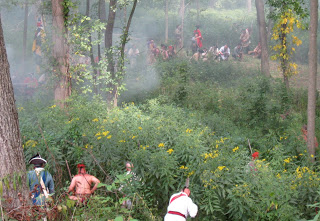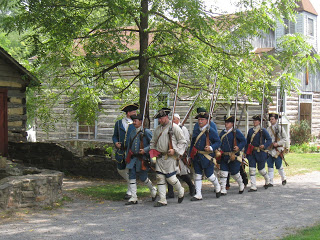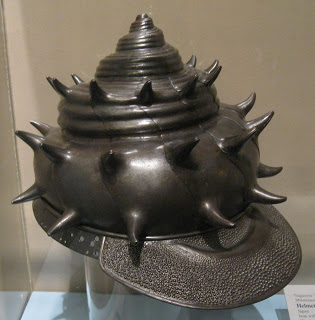Last weekend we went to Old Bedford Village. This is a historical reenactment village in central PA, similar to places such as Colonial Williamsburg, Old Sturbridge Village, or Strawbery Banke. This weekend was Drums in the Forest: a reenactment of Braddock’s Defeat held every 5 years in the forest just outside the village.
 We arrived in the midst of the reenactment. As with most publicly viewable reenactments I’ve seen, this one seemed heavy on the show and light on accuracy (or, maybe I’m just an eternal critic who doesn’t know what he’s talking about). It seems that when you’re reenacting a specific event, it’s hard to find enough properly uniformed troops, these days. There were plenty of irregulars, but there didn’t seem to be enough properly uniformed British. Truthfully, if I were tromping through these woods I’d leave my bright red coat at home too.
We arrived in the midst of the reenactment. As with most publicly viewable reenactments I’ve seen, this one seemed heavy on the show and light on accuracy (or, maybe I’m just an eternal critic who doesn’t know what he’s talking about). It seems that when you’re reenacting a specific event, it’s hard to find enough properly uniformed troops, these days. There were plenty of irregulars, but there didn’t seem to be enough properly uniformed British. Truthfully, if I were tromping through these woods I’d leave my bright red coat at home too.
There was lots of smoke and plenty of muzzle flashes, but I had a hard time avoiding the image of a bunch of boys running around in the woods yelling “Bang!” (and this is coming from a “grown man” who plays with toy soldiers as a hobby).
 Although I found the reenactment a bit disappointing, I consider that to be my fault and not theirs. The whole family thoroughly enjoyed our visit to the village, and I was able to have fun once I managed to put things into perspective. The permanent installations provided many good demonstrations of period industry and craft, and all of the reenactors looked and acted wonderful as long as I ignored the context of the massacre they attempted to demonstrate. The reenactor’s tent encampment would have been a lot more interesting to me than the reenactment itself, but since they were actually living there (for the night), it felt like a big invasion of their limited privacy even though they probably expected it. I expect the reenactors probably call us all “muggles” and complain about us behind our backs.
Although I found the reenactment a bit disappointing, I consider that to be my fault and not theirs. The whole family thoroughly enjoyed our visit to the village, and I was able to have fun once I managed to put things into perspective. The permanent installations provided many good demonstrations of period industry and craft, and all of the reenactors looked and acted wonderful as long as I ignored the context of the massacre they attempted to demonstrate. The reenactor’s tent encampment would have been a lot more interesting to me than the reenactment itself, but since they were actually living there (for the night), it felt like a big invasion of their limited privacy even though they probably expected it. I expect the reenactors probably call us all “muggles” and complain about us behind our backs.
Personally, I find the individual demonstrations of professions such as leatherworking, weaving, cooperage, candle making, tinsmithing, and basketmaking in the context of the homes or shops where they were done a lot more interesting than presenters talking to an audience about what was done and why. Orating about period Colonial dress is not as compelling to me as seeing the place someone lived, and experiencing the limitations of their life that inspired the solutions they implemented in their industry.
The buildings at Bedford have interesting stories as well. Some of them were moved, log by log and stone by stone, from other locations to this site. I’m reminded of the family who tore out their new house’s “modernized” drywall to find a log cabin underneath… and they were wondering why it was so hard to run wires through the walls?




